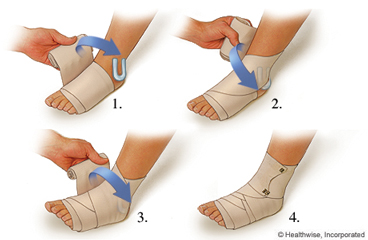
What is a compression bandage?
A compression bandage is a long strip of stretchable cloth that you can wrap around a sprain or strain. It's also called an elastic bandage or an ACE bandage. The gentle pressure of the bandage helps reduce swelling, so it may help the injured area feel better.
Elastic sleeves that you can pull over an injured area work the same way. Bandages and sleeves are not expensive. You can buy them at most drugstores.
How do you use one?
A compression bandage may help most to prevent swelling in the first few days after your injury. You can wear it longer than that, as long as it doesn't make your pain worse.
Putting on a compression bandage is easy, and you can do it at home. The steps are similar, whether for a wrist, an ankle, or anywhere else you would wear one. Follow any instructions that come with the bandage.
Wrapping an ankle
First, cut several horseshoe-shaped pieces of cloth felt to form a half-inch-thick pad. Place the pad (open end up) under the anklebone to help keep fluid out of the hollow place under your anklebone.
Next, if it isn't rolled already, roll up the elastic bandage. Hold your ankle at about a 90-degree angle. Start at the base of your toes. Wrap the bandage around the ball of your foot once, keeping it somewhat taut with a light pull.
After this first wrap, slowly start circling your way around the arch of the foot. Pull the bandage across from the bottom of the toes over the top of the foot and circle it around the ankle. Now bring the bandage across and down over the top of the foot and under the arch in a figure-eight pattern.
When you get to the anklebone, wrap the bandage around the felt piece so it stays in place under the anklebone. Continue around the ankle and foot in a figure eight, moving toward the heel on the bottom and up toward the calf. The wrap should cover the entire foot from the base of the toes to several inches above the ankle. Secure the end with clip fasteners or tape.
Wrapping a wrist
If it isn't rolled already, roll up the elastic bandage. Wrap the bandage around the hand a few times, beginning at the base of the fingers. Then wrap it around the hand between the thumb and index finger. Circle the wrist several times, ending a few inches above the wrist. Secure the end with clip fasteners or tape.
What should you know about using a compression bandage?
The bandage should be snug, but it should not cut off circulation. Check your toes (if the bandage is wrapped around your foot or ankle) or fingers (if it's around your wrist). If they become purplish or blue, cool to the touch, or numb or tingly, the wrap is too tight and should be loosened.
Loosen the wrap at night before bedtime.
Compression bandages do not offer protection. For example, if your ankle is wrapped, you also need a brace to protect your ankle if you try to put weight on it.
Keep the bandage clean between uses. Wash it by hand in warm soapy water. Then rinse it, and let it air dry.
Current as of: October 1, 2025
Author: Ignite Healthwise, LLC Staff
Clinical Review Board
All Ignite Healthwise, LLC education is reviewed by a team that includes physicians, nurses, advanced practitioners, registered dieticians, and other healthcare professionals.

